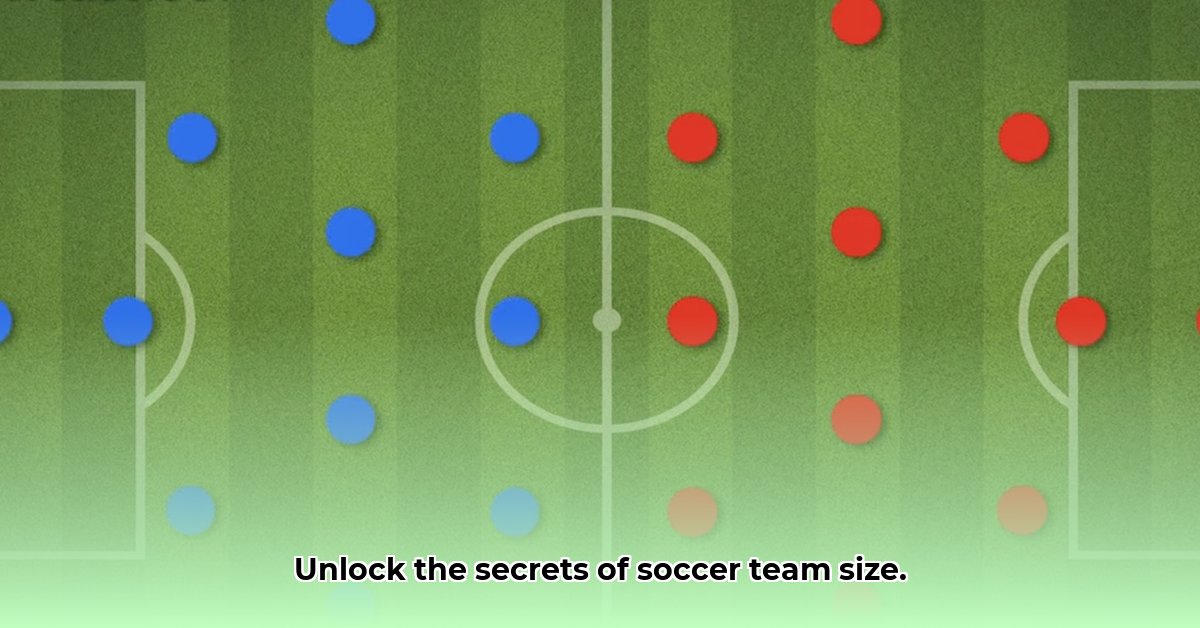So, you want to know how many players are on a soccer team? The short answer is 11, but that’s just the tip of the iceberg! There’s a whole lot more to it than that, with different rules about substitutes, minimum players needed, and how things change depending on whether you’re watching a pro game, a youth league match, or even something like futsal. For a more detailed explanation, check out this helpful guide: Soccer Team Sizes. This guide breaks it all down, making it easy to understand—no matter how much you already know about the sport.
Understanding Soccer Team Composition
It’s a question that seems simple at first glance, but the answer’s a bit more nuanced than you might think. It all depends on the level of play and even the specific league rules! Let’s break it down and consider the diverse soccer league guidelines.
The Basics: Eleven Players on the Pitch
In most soccer games – from professional leagues to your local weekend pickup game – you’ll see eleven players on each team when the match kicks off. This is the standard starting lineup, the foundation upon which the beautiful game is built. These eleven players include a goalkeeper, defenders, midfielders, and forwards, all working together to score goals and prevent the other team from doing the same. Each position requires a different skillset and contributes to the overall strategy.
- Goalkeeper: The last line of defense, tasked with preventing the opposition from scoring.
- Defenders: Protect the goal and thwart opposing attacks.
- Midfielders: Control the flow of the game, linking defense and attack.
- Forwards: Primarily responsible for scoring goals.
Substitutions: The Art of the Tactical Swap
This is where things get interesting. The number of substitutes allowed isn’t a universal constant; it varies quite a bit depending on the league and age group. Think of substitutes as a manager’s strategic tool – a way to freshen up a tired team, bring in a specialist player for a specific situation, or counter an opponent’s strategy. The ability to change players during a game adds a whole extra layer of strategy and excitement. This adds another layer of tactical gameplay to soccer team dynamics.
How many subs are allowed? That depends. Some leagues stick to a relatively small number, while others allow for significant changes during the course of a game. Let’s take a peek at some examples. Keep in mind that these rules are subject to change, even within the same league, so always check the official rules beforehand. Note that UEFA competitions allowed up to five substitutions as of 2020 to reduce physical impact on players.
| League | Maximum Substitutes Available | Subs Allowed Per Game | Players Allowed To Re-enter |
|---|---|---|---|
| Premier League | 9 | 5 | No |
| La Liga | 9 | 5 | No |
| Major League Soccer (MLS) | 9 | 5 | No |
| FIFA World Cup | 15 | 5 | No |
| Many Youth Leagues | Varies significantly | Varies significantly | Varies significantly |
As you can see, there’s quite a bit of variation. Youth leagues, in particular, often have more flexible rules depending on the age group and the specific organization running the league. The focus is often more on participation and player development than the strict tactical maneuvering of professional teams. Is it clear how leagues promote participation and skill-building in youth soccer through flexible substitution regulations? This promotes player development and allows coaches to experiment with different lineups.
The Minimum: Keeping the Game Alive
Accidents – like injuries or red cards – happen. So, what happens if a team ends up with fewer than eleven players? Most leagues have rules to allow play to continue even if a team is short a player or two. They generally require a minimum of seven players on the field for a team to continue participating. If a team falls below this threshold, the match is typically forfeited. While this might make things tough, it’s all about ensuring fair play and keeping the match going whenever possible.
Youth Soccer: A Different Playing Field
When it comes to younger players, expect to see things done differently. Youth soccer often plays with fewer players per team, frequently involving teams of five, seven, or nine players. This is intentional, reflecting the needs of developing players, and the emphasis here is more on introducing kids to the game, helping them build fundamentals, and having fun. Substitution rules are often more lenient too, aimed at ensuring everyone gets a chance to play. This allows for less pressure and more skill-building.
Other Variations: Beyond the Eleven-a-Side Game
The basic 11-a-side game we’ve been discussing is the most common, but it’s not the only type of soccer. Futsal, for example, is a fast-paced indoor version played with smaller teams (usually five players a side) on a smaller field. The rules are slightly different too; it’s a great way to improve skills in a different environment. Beach soccer is another variation, typically played 5-a-side. There are many other variations in other parts of the world as well, such as indoor soccer or arena soccer which typically features six or seven players on a team.
Strategy and Substitutions: The Manager’s Toolkit
The way coaches use their substitutions can be a major factor in a game’s outcome. A fresh player can be a game-changer, especially in the later stages when fatigue sets in. Strategic substitutions can also help exploit weaknesses in the opposing team, or change the overall game plan. Managers carefully consider players’ strengths, weaknesses, and current fitness levels when making decisions about who to put on the field. There’s often a lot of data analysis involved, especially at a professional level. Key factors in substitution strategy include:
- Fatigue Management: Bringing on fresh players to maintain energy levels.
- Tactical Adjustments: Changing the formation or personnel to counter the opponent.
- Injury Replacement: Swapping an injured player to maintain a full roster.
- Time Management: Using substitutions to run down the clock or add urgency.
Conclusion: It Depends!
So, how many players are on a soccer team? The simple answer is eleven, but the reality is far more complex. The number of players, the rules about substitutes, and even the minimum number needed to continue a game all vary greatly depending on factors ranging from the level of play to the specific governing body. The best approach is to always check the rules and regulations of the specific league or competition you’re interested in. The variety makes the game that much more interesting!
Optimizing Soccer Team Substitutions Based on League Rules
Key Takeaways:
- Prioritize player development over wins, especially in youth leagues.
- Communicate substitution policies clearly to players and parents beforehand.
- Implement a system for tracking player minutes to ensure fairness.
Standard Match Play: The Starting Eleven
A standard soccer match features two teams of eleven players each. This is consistent across professional and most amateur leagues. This basic setup forms the foundation upon which all substitution strategies are built.
Understanding Substitutions: The Art of the Swap
This is where things get interesting. How to optimize soccer team substitutions based on league rules requires a deep understanding of the specific regulations governing your league.
Number of Substitutions Allowed
The number of substitutes allowed varies considerably. Professional leagues, like the Premier League or La Liga, typically allow three to five substitutions. However, some leagues allow more, and youth leagues often have far more flexibility. A team might have more substitutions available in a youth game than a Champions League final.
| League Type | Typical Number of Substitutions | Notes |
|---|---|---|
| Professional | 3-5 | Varies by league and competition |
| Youth Leagues | Highly variable | Can range from unlimited in recreational leagues to fewer than professional leagues |
| FIFA Competitions | 3-5 | Often allows for more in extra time. |
| College Soccer | Unlimited | Can lead to significant tactical flexibility. |
Substitution Rules: The Fine Print
Knowing how many substitutions are allowed is only half the battle. Understanding the rules surrounding these substitutions is crucial. Can a substituted player return to the game? Are there time limits on substitutions? Are there specific times when substitutions can be made? These details are vital, and rules frequently differ between leagues. Always check your league’s specific rulebook.
Tactical Advantages: More Than Just Fresh Legs
Substitutions aren’t just about replacing tired players. They’re strategic maneuvers. Bringing in a fresh attacker can change the momentum of a tight game. Alternatively, you might substitute a defensive player to bolster your backline. Careful planning and in-game observation are keys to effective substitutions. Common tactical substitutions include:
- Bringing in a faster player to exploit a tired defense.
- Adding a more physical player to win aerial duels.
- Introducing a creative midfielder to unlock a stubborn defense.
- Switching formations to match the opponent’s strategy.
Minimum Players: Playing Short-Handed
What happens when injuries or ejections leave a team with fewer than eleven players? Most leagues have rules regarding the minimum number of players required to continue the game. These usually involve having a minimum of seven players on the pitch to keep the match going
- Discover Fermentation Revolution: The Health Benefits of Kimchi: Sustainable Farming Practices - July 30, 2025
- Discover Living Crystals: The Giant Gypsum Formations in Naica’s Cave: A Geological Marvel - July 30, 2025
- Master Molecular Gastronomy: The Science That Turns Your Kitchen into a Lab: Beginner-Friendly Recipes - July 30, 2025
















